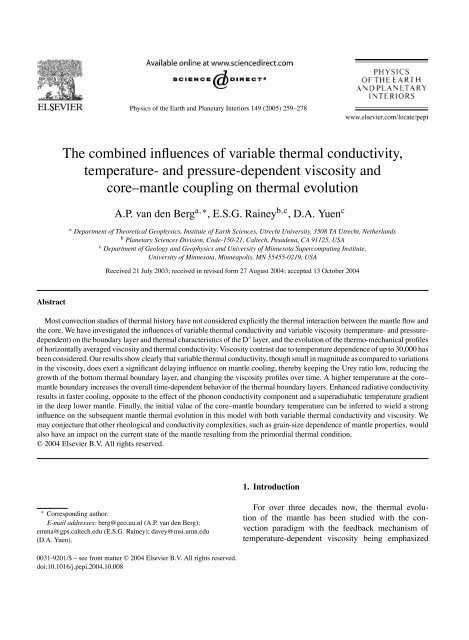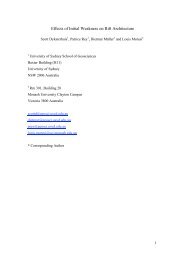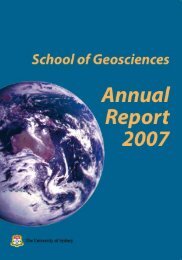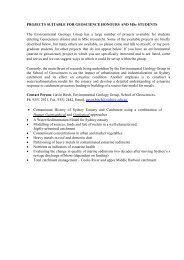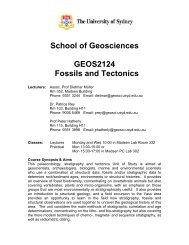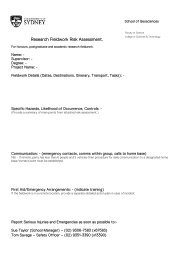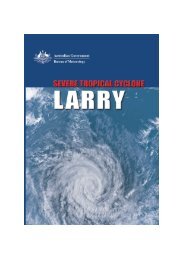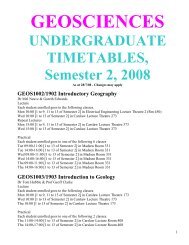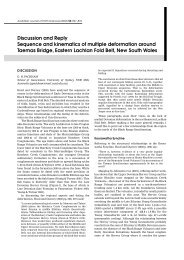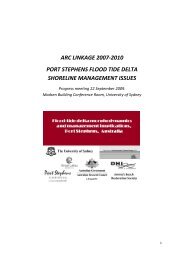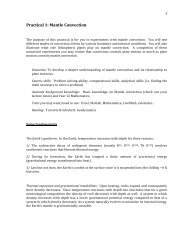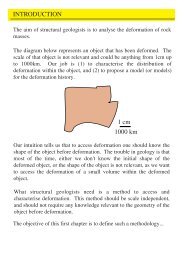van den Berg et al., 2005, Earth Planetary Science Letters.
van den Berg et al., 2005, Earth Planetary Science Letters.
van den Berg et al., 2005, Earth Planetary Science Letters.
You also want an ePaper? Increase the reach of your titles
YUMPU automatically turns print PDFs into web optimized ePapers that Google loves.
Physics of the <strong>Earth</strong> and Plan<strong>et</strong>ary Interiors 149 (<strong>2005</strong>) 259–278<br />
The combined influences of variable therm<strong>al</strong> conductivity,<br />
temperature- and pressure-depen<strong>den</strong>t viscosity and<br />
core–mantle coupling on therm<strong>al</strong> evolution<br />
A.P. <strong>van</strong> <strong>den</strong> <strong>Berg</strong> a,∗ , E.S.G. Rainey b,c , D.A. Yuen c<br />
a Department of Theor<strong>et</strong>ic<strong>al</strong> Geophysics, Institute of <strong>Earth</strong> <strong>Science</strong>s, Utrecht University, 3508 TA Utrecht, N<strong>et</strong>herlands<br />
b Plan<strong>et</strong>ary <strong>Science</strong>s Division, Code-150-21, C<strong>al</strong>tech, Pasa<strong>den</strong>a, CA 91125, USA<br />
c Department of Geology and Geophysics and University of Minnesota Supercomputing Institute,<br />
University of Minnesota, Minneapolis, MN 55455-0219, USA<br />
Received 21 July 2003; received in revised form 27 August 2004; accepted 13 October 2004<br />
Abstract<br />
Most convection studies of therm<strong>al</strong> history have not considered explicitly the therm<strong>al</strong> interaction b<strong>et</strong>ween the mantle flow and<br />
the core. We have investigated the influences of variable therm<strong>al</strong> conductivity and variable viscosity (temperature- and pressuredepen<strong>den</strong>t)<br />
on the boundary layer and therm<strong>al</strong> characteristics of the D ′′ layer, and the evolution of the thermo-mechanic<strong>al</strong> profiles<br />
of horizont<strong>al</strong>ly averaged viscosity and therm<strong>al</strong> conductivity. Viscosity contrast due to temperature depen<strong>den</strong>ce of up to 30,000 has<br />
been considered. Our results show clearly that variable therm<strong>al</strong> conductivity, though sm<strong>al</strong>l in magnitude as compared to variations<br />
in the viscosity, does exert a significant delaying influence on mantle cooling, thereby keeping the Urey ratio low, reducing the<br />
growth of the bottom therm<strong>al</strong> boundary layer, and changing the viscosity profiles over time. A higher temperature at the core–<br />
mantle boundary increases the over<strong>al</strong>l time-depen<strong>den</strong>t behavior of the therm<strong>al</strong> boundary layers. Enhanced radiative conductivity<br />
results in faster cooling, opposite to the effect of the phonon conductivity component and a superadiabatic temperature gradient<br />
in the deep lower mantle. Fin<strong>al</strong>ly, the initi<strong>al</strong> v<strong>al</strong>ue of the core–mantle boundary temperature can be inferred to wield a strong<br />
influence on the subsequent mantle therm<strong>al</strong> evolution in this model with both variable therm<strong>al</strong> conductivity and viscosity. We<br />
may conjecture that other rheologic<strong>al</strong> and conductivity complexities, such as grain-size depen<strong>den</strong>ce of mantle properties, would<br />
<strong>al</strong>so have an impact on the current state of the mantle resulting from the primordi<strong>al</strong> therm<strong>al</strong> condition.<br />
© 2004 Elsevier B.V. All rights reserved.<br />
1. Introduction<br />
∗ Corresponding author.<br />
E-mail addresses: berg@geo.uu.nl (A.P. <strong>van</strong> <strong>den</strong> <strong>Berg</strong>);<br />
emma@gps.c<strong>al</strong>tech.edu (E.S.G. Rainey); davey@msi.umn.edu<br />
(D.A. Yuen).<br />
For over three decades now, the therm<strong>al</strong> evolution<br />
of the mantle has been studied with the convection<br />
paradigm with the feedback mechanism of<br />
temperature-depen<strong>den</strong>t viscosity being emphasized<br />
0031-9201/$ – see front matter © 2004 Elsevier B.V. All rights reserved.<br />
doi:10.1016/j.pepi.2004.10.008
260 A.P. <strong>van</strong> <strong>den</strong> <strong>Berg</strong> <strong>et</strong> <strong>al</strong>. / Physics of the <strong>Earth</strong> and Plan<strong>et</strong>ary Interiors 149 (<strong>2005</strong>) 259–278<br />
(e.g. Tozer, 1972). The most extensive work using numeric<strong>al</strong><br />
convection models on therm<strong>al</strong> history has been<br />
conducted with depth-depen<strong>den</strong>t viscosity (Butler and<br />
Peltier, 2002).<br />
While the effects of temperature- and pressuredepen<strong>den</strong>t<br />
viscosity are well known in the steady state<br />
(e.g. Christensen, 1985), not much work has been carried<br />
out in therm<strong>al</strong> evolution with variable viscosity,<br />
save for the work by DeLandro-Clarke and Jarvis<br />
(1997). Moreover, a model for mantle therm<strong>al</strong> conductivity<br />
based on phonon solid-state physics and infrared<br />
spectroscopy was developed by Hofmeister (1999).<br />
Contributions from both phonon and photon conductivity<br />
are included in this model. Recently on the basis<br />
of spectroscopic work, Badro <strong>et</strong> <strong>al</strong>. (2004) have argued<br />
for the importance of radiative therm<strong>al</strong> conductivity in<br />
the deep mantle.<br />
<strong>van</strong> <strong>den</strong> <strong>Berg</strong> <strong>et</strong> <strong>al</strong>. (2002) and <strong>van</strong> <strong>den</strong> <strong>Berg</strong> and<br />
Yuen (2002) have shown that variable therm<strong>al</strong> conductivity<br />
can delay the secular cooling of the mantle with<br />
a constant viscosity model. Since variations of viscosity<br />
in the course of therm<strong>al</strong> evolution are much greater<br />
than changes in the therm<strong>al</strong> conductivity, it is therefore<br />
important to ev<strong>al</strong>uate the influence of variable viscosity<br />
on the effects of delayed secular cooling and <strong>al</strong>so the<br />
stabilization of boundary layer activities at the core–<br />
mantle boundary (CMB) from increasing the radiative<br />
contribution to the therm<strong>al</strong> conductivity (Dubuff<strong>et</strong> <strong>et</strong><br />
<strong>al</strong>., 2002).<br />
Another important aspect of therm<strong>al</strong> history is the<br />
influence from therm<strong>al</strong> coupling of the mantle to the<br />
core. This was first studied within the framework of<br />
one-dimension<strong>al</strong> param<strong>et</strong>erized convection models by<br />
Sharpe and Peltier (1978) and Schubert <strong>et</strong> <strong>al</strong>. (1979)<br />
and in fully two-dimension<strong>al</strong> (Steinbach <strong>et</strong> <strong>al</strong>., 1993;<br />
Honda and Yuen, 1994) and three-dimension<strong>al</strong> (Yuen<br />
<strong>et</strong> <strong>al</strong>., 1994) convection models. Buff<strong>et</strong>t <strong>et</strong> <strong>al</strong>. (1992)<br />
and recently Buff<strong>et</strong>t (2003) pointed out the importance<br />
of core–mantle interactions in therm<strong>al</strong>-chemic<strong>al</strong> evolution.<br />
The heat flux at the core–mantle boundary (CMB) is<br />
of particular interest for plan<strong>et</strong>ary evolution. It controls<br />
the relative partitioning b<strong>et</strong>ween bottom heating and<br />
intern<strong>al</strong> heating in the lower mantle, and it <strong>al</strong>so has important<br />
implications for the geodynamo and the chemic<strong>al</strong><br />
composition the core. The current CMB heat flux is<br />
relatively poorly constrained, but recent estimates indicate<br />
that the heat flux may be much higher than early<br />
estimates, perhaps as high as 12 TW (Buff<strong>et</strong>t, 2003).<br />
An important minimum constraint on core heat flux is<br />
the heat necessary to drive the geodynamo and generate<br />
a magn<strong>et</strong>ic field, which has probably existed for at<br />
least 3.5 Gyr. Best estimates indicate that prior to the<br />
solidification of the inner core, known sources of heat<br />
in the core are insufficient to drive a magn<strong>et</strong>ic dynamo.<br />
40 K, which is depl<strong>et</strong>ed in the mantle, was suggested<br />
as a possible source of radioactivity in the core that<br />
could provide heat necessary for the geodynamo (e.g.,<br />
H<strong>al</strong>l and Murthy, 1971; Gessman and Wood, 2002).<br />
Although potassium was not thought be a siderophile,<br />
recent experiment<strong>al</strong> evi<strong>den</strong>ce shows that 40 K can enter<br />
iron sulphide melts under core conditions (Murthy <strong>et</strong><br />
<strong>al</strong>., 2003). The amount of 40 K in the core can be constrained<br />
by the core heat budg<strong>et</strong>, which depends on how<br />
much heat is conducted from the core into the mantle.<br />
For obtaining b<strong>et</strong>ter estimates of the heat flux at the<br />
CMB, it is necessary to use a model that includes a<br />
re<strong>al</strong>istic mantle therm<strong>al</strong> conductivity, especi<strong>al</strong>ly in the<br />
lower mantle, where radiative conductivity effects can<br />
be stronger than the phonon conductivity (Yuen <strong>et</strong> <strong>al</strong>.,<br />
2000) and can <strong>al</strong>so be enhanced by iron concentration<br />
in the D ′′ layer (Manga and Jeanloz, 1996).<br />
In Section 2 we describe the models for 2D mantle<br />
convection and the therm<strong>al</strong> conductivity. In subsequent<br />
sections we focus respectively on the the effects<br />
of varying initi<strong>al</strong> CMB temperatures, the enhancement<br />
of radiative therm<strong>al</strong> conductivity and the tempor<strong>al</strong> development<br />
of the therm<strong>al</strong> structure of the mantle in the<br />
core-coupling model.<br />
In the fin<strong>al</strong> section we will state our conclusions and<br />
offer our perspectives for the role played by variable<br />
viscosity acting in concert with variable therm<strong>al</strong> conductivity<br />
in particular in view of the effects of enhanced<br />
radiative conductivity as indicated in recent miner<strong>al</strong><br />
physics results (Badro <strong>et</strong> <strong>al</strong>., 2004), and core–mantle<br />
coupling in shaping the therm<strong>al</strong> history.<br />
2. Description of the convection, conduction<br />
and viscosity models<br />
We use a 2D mantle convection model including<br />
therm<strong>al</strong> coupling to the core. Fig. 1 shows a diagram<br />
of the cartesian computation<strong>al</strong> domain, illustrating the<br />
therm<strong>al</strong> coupling b<strong>et</strong>ween mantle and core included<br />
in our model. An aspect-ratio of 2.5 for the compu-
A.P. <strong>van</strong> <strong>den</strong> <strong>Berg</strong> <strong>et</strong> <strong>al</strong>. / Physics of the <strong>Earth</strong> and Plan<strong>et</strong>ary Interiors 149 (<strong>2005</strong>) 259–278 261<br />
Fig. 1. Domain diagram showing the earth’s therm<strong>al</strong>ly coupled mantle and core in a spheric<strong>al</strong> configuration (top) and in a cartesian 2D box of<br />
aspect ratio 2.5, used in the numeric<strong>al</strong> mantle convection model. The core is represented by an isotherm<strong>al</strong> heat reservoir, therm<strong>al</strong>ly coupled to<br />
the convecting mantle. This core reservoir is cooled by the heat flux into the mantle driven by the temperature contrast δT across the bottom<br />
boundary layer of the mantle. In this model the temperature contrast across the convecting mantle T CMB (t) − T surface decreases with the cooling<br />
of the core.<br />
tation<strong>al</strong> domain has been considered throughout. This Symbols used in (1)–(4) are defined in Table 1. In<br />
same aspect-ratio was employed in our previous works Eq. (4) D/Dt <strong>den</strong>otes the substantive derivative. H(t)<br />
(<strong>van</strong> <strong>den</strong> <strong>Berg</strong> and Yuen, 1998; <strong>van</strong> <strong>den</strong> <strong>Berg</strong> <strong>et</strong> <strong>al</strong>., is an exponenti<strong>al</strong> decaying function and R is a nondimension<strong>al</strong><br />
measure of radiogenic strength. For the<br />
2002).<br />
The mantle convection model is based on the intern<strong>al</strong> heating of the model we use a uniform distribution<br />
with exponenti<strong>al</strong> time depen<strong>den</strong>ce H(t) char-<br />
extended Boussinesq approximation for an infinite<br />
Prandtl number, incompressible fluid (Steinbach <strong>et</strong> <strong>al</strong>., acterized by a h<strong>al</strong>f-life time of 2.5 Gyr, and an initi<strong>al</strong><br />
1989). In this model conservation of mass, momentum v<strong>al</strong>ue of the intern<strong>al</strong> heating number R equ<strong>al</strong> to 20,<br />
and energy and the constitutive rheologic<strong>al</strong> relation are corresponding to an intern<strong>al</strong> heating, which is about a<br />
expressed in the following non-dimension<strong>al</strong> equations factor of two stronger than the present-day chondritic<br />
DT<br />
termediate case of sever<strong>al</strong> models with different initi<strong>al</strong><br />
CMB temperature T CMB (0). We used temperature<br />
= ∂ j (κ(T, P)∂ j T ) + αDiw(T + T 0 )<br />
Dt<br />
+ Di<br />
contrasts of 3000, 3500 and 4000 K, corresponding to<br />
Ra + RH(t) (4) initi<strong>al</strong> core–mantle boundary temperatures T CMB (0) of<br />
∂ j u j = 0 (1)<br />
v<strong>al</strong>ue.<br />
For the non-dimension<strong>al</strong>ization scheme we used the<br />
− ∂ i P + ∂ j τ ij = αRaTδ i3 (2) depth of the convecting layer h as the spati<strong>al</strong> sc<strong>al</strong>e and<br />
τ ij = η(T, P)(∂ j u i + ∂ i u j ) (3)<br />
h 2 /κ 0 , a therm<strong>al</strong> diffusion time of the layer, as the time<br />
sc<strong>al</strong>e. The temperature sc<strong>al</strong>e T corresponds to the<br />
initi<strong>al</strong> temperature contrast across the layer, of an in-
262 A.P. <strong>van</strong> <strong>den</strong> <strong>Berg</strong> <strong>et</strong> <strong>al</strong>. / Physics of the <strong>Earth</strong> and Plan<strong>et</strong>ary Interiors 149 (<strong>2005</strong>) 259–278<br />
Table 1<br />
Physic<strong>al</strong> param<strong>et</strong>ers<br />
Symbol Definition V<strong>al</strong>ue Unit<br />
h Height of the mantle model 3 × 10 6 m<br />
z Depth coordinate <strong>al</strong>igned with gravity – –<br />
P Static pressure – –<br />
P Dynamic pressure – –<br />
T Temperature – –<br />
T surface Surface temperature 273 K<br />
T Temperature sc<strong>al</strong>e 3500 K<br />
u i Velocity field component – –<br />
e ij = ∂ j u i + ∂ i u j Strain rate tensor – –<br />
[<br />
e =<br />
1<br />
2e ij e ij<br />
] 1/2<br />
Second invariant of strain rate – –<br />
w Vertic<strong>al</strong> velocity <strong>al</strong>igned with gravity – –<br />
η(T, z) = η 0 exp(cz − bT ) Temperature and pressure/depth depen<strong>den</strong>t viscosity – –<br />
η 0 Viscosity sc<strong>al</strong>e v<strong>al</strong>ue – Pa s<br />
τ ij = ηe ij Viscous stress tensor – –<br />
= ηe 2 Viscous dissipation function –<br />
α(z) =<br />
α<br />
[c(1 − z) + 1] 3 Depth depen<strong>den</strong>t therm<strong>al</strong> expansivity –<br />
α = α(1) – –<br />
c = α 1/3 − 1 –<br />
α 0 Therm<strong>al</strong> expansivity sc<strong>al</strong>e v<strong>al</strong>ue 2 × 10 −5 K −1<br />
ρ Density – –<br />
ρ 0 Density sc<strong>al</strong>e v<strong>al</strong>ue 4000 kg m −3<br />
c p Specific heat 1250 J K −1 kg −1<br />
k Therm<strong>al</strong> conductivity – –<br />
k 0 Conductivity sc<strong>al</strong>e v<strong>al</strong>ue 4.7 W m −1 K −1<br />
a Conductivity powe-law index 0.3 –<br />
γ Grueneisen param<strong>et</strong>er 1.2 –<br />
K 0 Bulk modulus 261 GPa<br />
K 0 ′ Pressure derivative of bulk modulus 5 –<br />
b 0 Coefficient photon conductivity 1.7530 × 10 −2<br />
b 1<br />
−1.0365 × 10 −4<br />
b 2<br />
2.2451 × 10 −7<br />
b 3<br />
−3.4071 × 10 −11<br />
κ =<br />
k<br />
ρc p<br />
Therm<strong>al</strong> diffusivity – –<br />
g Gravitation<strong>al</strong> acceleration 9.8 m s −2<br />
( ) −t<br />
H(t) = H 0 exp<br />
τ<br />
Time-depen<strong>den</strong>t intern<strong>al</strong> heating – W kg −1<br />
τ Dimension<strong>al</strong> decay time of radioactive heating 3.6 Gyr<br />
H 0 Dimension<strong>al</strong> v<strong>al</strong>ue of intern<strong>al</strong> heating – W kg −1<br />
R = H 0h 2<br />
c p κ 0 T<br />
Non-dimension<strong>al</strong> intern<strong>al</strong> heating number 20 –<br />
Ra = ρ 0α 0 gTh 3<br />
κ 0 η 0<br />
Rayleigh number – –<br />
Di = α 0gh<br />
c p<br />
Dissipation number 0.47 –<br />
q C (t) Average heatflow <strong>den</strong>sity at the CMB – –<br />
X Ratio of core to mantle heat capacity 0.44 –
A.P. <strong>van</strong> <strong>den</strong> <strong>Berg</strong> <strong>et</strong> <strong>al</strong>. / Physics of the <strong>Earth</strong> and Plan<strong>et</strong>ary Interiors 149 (<strong>2005</strong>) 259–278 263<br />
3273, 3773 and 4273 K. The initi<strong>al</strong> temperature field<br />
of the mantle in the cases with different T CMB (0) were<br />
computed by applying an appropriate uniform sc<strong>al</strong>ing<br />
factor to the initi<strong>al</strong> mantle temperature of the intermediate<br />
case (T CMB (0) = 3773 K). The latter is obtained<br />
from a statistic<strong>al</strong>ly steady-state equilibrium model run<br />
with enhanced (R = 40) and constant intern<strong>al</strong> heating<br />
with a zero heat flux bottom boundary.<br />
For the therm<strong>al</strong> diffusivity κ = k(T, P)/ρc p we use<br />
the temperature- and pressure-depen<strong>den</strong>t conductivity<br />
Hofmeister model (Hofmeister, 1999)<br />
( ) 298 a<br />
k(T, P) = k 0<br />
T<br />
× exp<br />
×<br />
[ (<br />
− 4γ + 1 )<br />
]<br />
α(P)(T − 298)<br />
3<br />
(<br />
1 + K′ 0 P )<br />
+<br />
K 0<br />
3∑<br />
fb i T i (5)<br />
i=0<br />
In (5) the first term gives the phonon contribution to the<br />
effective conductivity and the second term is the contribution<br />
from photon transport. The amplification factor<br />
f (e.g. <strong>van</strong> <strong>den</strong> <strong>Berg</strong> <strong>et</strong> <strong>al</strong>., 2002) of the photon term,<br />
v<strong>al</strong>ued f = 1 in the Hofmeister model (Hofmeister,<br />
1999), is used here as a control param<strong>et</strong>er to vary the<br />
relative contribution of both mechanisms in the effective<br />
therm<strong>al</strong> conductivity. We consider in particular<br />
models with f v<strong>al</strong>ues of 0, 1, 2 and 5 to investigate<br />
the impact of the radiative therm<strong>al</strong> conductivity on the<br />
model behavior. We have not considered the grain-size<br />
depen<strong>den</strong>ce of therm<strong>al</strong> conductivity, which can vary<br />
non-monotonic<strong>al</strong>ly with depth (Hofmeister, 2004).<br />
The phonon term decreases with increasing temperature,<br />
∂k lat /∂T < 0 and increases with increasing pressure,<br />
∂k lat /∂P > 0. The photon term on the other hand<br />
increases with temperature ∂k rad /∂T > 0 and is insensitive<br />
to pressure ∂k rad /∂P = 0.<br />
To interpr<strong>et</strong> the numeric<strong>al</strong> modelling results we will<br />
<strong>al</strong>so use the therm<strong>al</strong> resistivity, defined as the inverse of<br />
the therm<strong>al</strong> conductivity r = 1/k, in an<strong>al</strong>ogy with the<br />
theory of electricity. One-dimension<strong>al</strong> depth profiles of<br />
horizont<strong>al</strong>ly averaged resistivity can then be integrated<br />
from a boundary point z b to obtain a resistance profile<br />
R(z) through therm<strong>al</strong> boundary layers of the mantle,<br />
the lithosphere and the CMB region<br />
R(z) =<br />
∫ z<br />
z b<br />
〈 1<br />
k(z ′ )<br />
〉<br />
dz ′ (6)<br />
This therm<strong>al</strong> resistance has been in use in geothermics<br />
as a means of obtaining reliable heatflow estimates<br />
from bore holes with strongly fluctuating conductivity<br />
profiles (Beardsmore and Cull, 2001; Bullard,<br />
1939).<br />
For the rheologic<strong>al</strong> model we have chosen an exponenti<strong>al</strong><br />
temperature and depth (pressure) depen<strong>den</strong>t<br />
viscosity for Newtonian rheology<br />
η(T, z) = η 0 exp(cz − bT ) (7)<br />
where c, b are defined in Table 1 in terms of the viscosity<br />
contrasts across the convecting layer due to depth<br />
(pressure) (η P ) and temperature (η T ), respectively.<br />
The v<strong>al</strong>ue of η P is fixed at 100. For most cases, the<br />
v<strong>al</strong>ue of η T is 3000, but for comparison we <strong>al</strong>so show<br />
some contrasting cases.<br />
Eqs. (1), (2) and (4) are solved by using finite element<br />
m<strong>et</strong>hods for the spati<strong>al</strong> discr<strong>et</strong>ization, and applying<br />
a pen<strong>al</strong>ty function m<strong>et</strong>hod for the continuity equation<br />
and Stokes momentum equations (1) and (2). The<br />
energy equation (4) which drives the time depen<strong>den</strong>t<br />
system is integrated in time using a predictor corrector<br />
m<strong>et</strong>hod (<strong>van</strong> <strong>den</strong> <strong>Berg</strong> <strong>et</strong> <strong>al</strong>., 1993). The finite element<br />
mesh consists of 150 × 140 nod<strong>al</strong> points in the<br />
horizont<strong>al</strong> and vertic<strong>al</strong> direction, respectively. Mesh refinement<br />
was applied near the horizont<strong>al</strong> boundaries,<br />
where the vertic<strong>al</strong> nod<strong>al</strong> point spacing was reduced to<br />
6 km from a v<strong>al</strong>ue of 30 km in the interior domain.<br />
Mesh refinements near the therm<strong>al</strong> boundary layers<br />
is essenti<strong>al</strong> in c<strong>al</strong>culations using variable conductivity<br />
due to the occurrence of strong temperature gradients<br />
and similar sharp variations in the effective therm<strong>al</strong><br />
conductivity in the boundary layer (see Yuen <strong>et</strong><br />
<strong>al</strong>., 2000), which need to be resolved numeric<strong>al</strong>ly. Especi<strong>al</strong>ly<br />
the computation of the surface heat-flux requires<br />
a very high resolution of the finite element mesh<br />
(<strong>van</strong> <strong>den</strong> <strong>Berg</strong> <strong>et</strong> <strong>al</strong>., 2001).<br />
We use free-slip impermeable boundaries and a<br />
fixed top surface temperature of 273 K. On the vertic<strong>al</strong><br />
boundaries a zero heat flux symm<strong>et</strong>ry condition<br />
was applied. The model runs were started<br />
from a statistic<strong>al</strong>ly steady state obtained for a zero<br />
heat flux bottom boundary and constant intern<strong>al</strong><br />
heating.<br />
Therm<strong>al</strong> coupling b<strong>et</strong>ween mantle and core is represented<br />
by an isotherm<strong>al</strong> heat reservoir of the core,<br />
shown in Fig. 1, where the temperature T C is controlled<br />
by the average heat-flow from the core–mantle bound-
264 A.P. <strong>van</strong> <strong>den</strong> <strong>Berg</strong> <strong>et</strong> <strong>al</strong>. / Physics of the <strong>Earth</strong> and Plan<strong>et</strong>ary Interiors 149 (<strong>2005</strong>) 259–278<br />
ary q C described by the ordinary differenti<strong>al</strong> equation<br />
(Steinbach <strong>et</strong> <strong>al</strong>., 1993)<br />
dT C<br />
dt<br />
A<br />
= − q C (t) (8)<br />
ρ C c PC V C<br />
where A is the area of the core–mantle boundary surface<br />
and C C = ρ C c PC V C is the tot<strong>al</strong> heat capacity of the<br />
core. The core heat capacity is expressed as a fraction<br />
X of the mantle heat capacity C M , resulting in an O.D.E.<br />
for T C (t):<br />
dT C<br />
dt<br />
= − 1<br />
Xρc p h q C(t) (9)<br />
where ρ and c p are the mantle v<strong>al</strong>ues of <strong>den</strong>sity and<br />
heat capacity. Param<strong>et</strong>er v<strong>al</strong>ues are given in Table 1.<br />
At each time step T C is updated by integrating (9),<br />
using the average heatflow v<strong>al</strong>ue q C , computed from<br />
the finite element solution for the mantle temperature<br />
field. This is done by forward extrapolation in time<br />
of the heat flux in an Euler type scheme. The updated<br />
uniform core temperature is then taken as a time depen<strong>den</strong>t<br />
boundary condition for the finite element computation<br />
of the mantle temperature in the next time step, so<br />
T CMB (t) = T C (t) in (9). We note that an<strong>al</strong>ytic<strong>al</strong> asymptotic<br />
m<strong>et</strong>hods (Solomatov and Zharkov, 1990) for treating<br />
therm<strong>al</strong> history, though capable of handling variable<br />
viscosity, may be hard-pressed to apply in the case<br />
of variable therm<strong>al</strong> conductivity.<br />
3. Results<br />
A comparison of a series of temperature snapshots<br />
for typic<strong>al</strong> secular cooling runs for two different v<strong>al</strong>ues<br />
of the T CMB (0) = 3273 and 4273 K is shown in Fig. 2.<br />
The snapshots represent a time span of about the age<br />
of the <strong>Earth</strong>, illustrating the effects of different initi<strong>al</strong><br />
T CMB (0), showing faster cooling for the hotter initi<strong>al</strong><br />
temperature case.<br />
In previous work we have investigated the impact<br />
of variable conductivity on the secular cooling of the<br />
convecting mantle, restricted to isoviscous models (<strong>van</strong><br />
<strong>den</strong> <strong>Berg</strong> and Yuen, 2002) and to models with temperature<br />
depen<strong>den</strong>ce of the viscosity limited to around<br />
1000 (<strong>van</strong> <strong>den</strong> <strong>Berg</strong> <strong>et</strong> <strong>al</strong>., 2004). Here we consider<br />
models including pressure and temperature depen<strong>den</strong>t<br />
viscosity given by (7) with a higher v<strong>al</strong>ue of the temperature<br />
depen<strong>den</strong>ce. In contrast to previous work we<br />
<strong>al</strong>so focus on the opposite role of the different heat<br />
transport mechanisms (phonons versus photons) in the<br />
composite conductivity model. Fin<strong>al</strong>ly we introduce<br />
here therm<strong>al</strong> coupling b<strong>et</strong>ween the convecting mantle<br />
and a therm<strong>al</strong> reservoir representing the core. Photon<br />
conductivity is likely to be dominant in the lower mantle<br />
and hence important for therm<strong>al</strong> core/mantle coupling.<br />
Phonon conductivity is suppressed by the 1/T<br />
temperature depen<strong>den</strong>ce.<br />
The effect of varying η T on the over<strong>al</strong>l cooling<br />
history of the coupled mantle and core system is presented<br />
in Figs. 3 and 4. The cooling curves in Fig. 3,<br />
show the volume averaged temperature of the mantle,<br />
comparing <strong>al</strong>so the variable conductivity cases with the<br />
corresponding constant conductivity cases. The corresponding<br />
constant conductivity cases have the same<br />
surface conductivity v<strong>al</strong>ue as the variable conductivity<br />
cases. For the conductivity model with f = 1 this <strong>al</strong>so<br />
corresponds to an approximately similar v<strong>al</strong>ue of the<br />
volume average conductivity. This was <strong>al</strong>so shown in<br />
previous work, Fig. 7 of <strong>van</strong> <strong>den</strong> <strong>Berg</strong> and Yuen (2002).<br />
The main feature of the results shown in Figs. 3 and<br />
4 is a similar cooling delay of the variable conductivity<br />
models with respect to the corresponding constant<br />
conductivity models. This amounts to an accumulated<br />
delay time of <strong>al</strong>most two billion years at a model time of<br />
4.5 Gyr. These results indicate that the delay we found<br />
earlier in secular cooling in isoviscous models with<br />
variable conductivity is a robust phenomenon, <strong>al</strong>so in<br />
models including variable viscosity. The results <strong>al</strong>so<br />
show that the trend in the cooling rate, for increasing<br />
η T , is non-monotonic. It appears that cooling is<br />
slightly slower for η T = 3 × 10 3 (Fig. 3b) than for<br />
η T = 3 × 10 2 (Fig. 3a). Increasing the temperature<br />
to η T = 3 × 10 4 the cooling rate increases <strong>al</strong>so (Fig.<br />
3c). This non-monotonic trend is the same for constant<br />
conductivity models represented by the dashed curves.<br />
The sm<strong>al</strong>l difference in the over<strong>al</strong>l cooling behavior b<strong>et</strong>ween<br />
the three contrasting viscosity cases is surprising<br />
inview of the significant difference of the interior viscosity<br />
shown for these cases shown in Fig. 4. It appears<br />
from these results that one cannot simply apply the temperature<br />
depen<strong>den</strong>ce of the viscosity to predict an increased<br />
cooling rate for increasing η T . The pressure<br />
depen<strong>den</strong>ce of the viscosity complicates the d<strong>et</strong>ails of<br />
the resulting temperature distribution which feeds back<br />
into the viscosity, resulting in this non-monotonic behavior.
A.P. <strong>van</strong> <strong>den</strong> <strong>Berg</strong> <strong>et</strong> <strong>al</strong>. / Physics of the <strong>Earth</strong> and Plan<strong>et</strong>ary Interiors 149 (<strong>2005</strong>) 259–278 265<br />
Fig. 2. Snapshots of the temperature field for two different initi<strong>al</strong> CMB temperatures T CMB = 3273 and 4273 K. The variable conductivity model<br />
used is the same in both cases with f = 1. Different temperature sc<strong>al</strong>es have been used b<strong>et</strong>ween the initi<strong>al</strong>ly hotter and cooler model cases. The<br />
difference in the therm<strong>al</strong> evolution of the convecting mantle is illustrated by a series of snapshots spanning the age of the earth. The hot model<br />
in the righthand column shows a significantly faster cooling than the initi<strong>al</strong>ly cooler model. The hot model <strong>al</strong>so shows sm<strong>al</strong>ler sc<strong>al</strong>e convective<br />
features then the cooler model.<br />
Depth profiles of temperature and viscosity are<br />
shown in Fig. 4 for three cases with contrasting temperature<br />
depen<strong>den</strong>ce of the viscosity η T = 300, 3000<br />
and 30,000. The conductivity model used is the same in<br />
<strong>al</strong>l three cases, corresponding to the Hofmeister (1999)<br />
model with f = 1. The initi<strong>al</strong> v<strong>al</strong>ue T CMB (0) is 3773 K<br />
in <strong>al</strong>l cases and the snapshot corresponds to an integration<br />
time of 4.428 Gyr. Intern<strong>al</strong> temperatures for the<br />
three cases shown are roughly similar, with a larger<br />
temperature difference of sever<strong>al</strong> hundred degrees in a<br />
layer of 500 km above the CMB. The variation in the<br />
corresponding horizont<strong>al</strong>ly averaged viscosity is b<strong>et</strong>ween<br />
one and two orders of magnitude b<strong>et</strong>ween the different<br />
model cases inline with the differences in η T .<br />
In order to investigate the mechanism behind the<br />
cooling delay of the variable conductivity models we<br />
have applied a 1D depth depen<strong>den</strong>t conductivity model.<br />
The corresponding conductivity, k a (z), is computed<br />
from the horizont<strong>al</strong>ly averaged conductivity, taken<br />
from a variable (Hofmeister, 1999) conductivity model<br />
with f = 1 substituted in (5). The 1D profile is defined<br />
as the time-averaged v<strong>al</strong>ue, for an averaging time<br />
window of 5 Gyr, of horizont<strong>al</strong>ly averaged conductivity<br />
snapshots. The result of this space and time averaging<br />
of the conductivity is shown in Fig. 5a. The<br />
sm<strong>al</strong>l variation of the effective conductivity profiles<br />
over time, due to the secular cooling, is illustrated by<br />
the width of the bundle of black curves. The time averaged<br />
profile k a (z) is represented by the red curve.<br />
We compared the therm<strong>al</strong> history of the variable conductivity<br />
model with the model based on the 1D profile<br />
k a (z). The viscosity model is kept the same in this com-
266 A.P. <strong>van</strong> <strong>den</strong> <strong>Berg</strong> <strong>et</strong> <strong>al</strong>. / Physics of the <strong>Earth</strong> and Plan<strong>et</strong>ary Interiors 149 (<strong>2005</strong>) 259–278<br />
Fig. 3. Therm<strong>al</strong> evolution curves showing volume averaged temperature<br />
of the convecting mantle against integration time 〈T (t)〉, for three<br />
models characterized by different v<strong>al</strong>ues of the temperature depen<strong>den</strong>ce<br />
of the viscosity, η T = 300, 3000 and 30,000. The variable<br />
conductivity model used is the same in <strong>al</strong>l cases with f = 1. Results<br />
for variable k, f = 1 are compared with corresponding constant conductivity<br />
models. A strong delaying effect on secular cooling of variable<br />
conductivity is clearly shown by these results. Furthermore this<br />
delay is robust for increasing v<strong>al</strong>ues of the temperature depen<strong>den</strong>ce<br />
of the viscosity.<br />
parison, η T = 3 × 10 3 , η P = 10 2 . Time series of<br />
glob<strong>al</strong> quantities for both cases are shown in Fig. 5b<br />
and c. Fig. 5b shows the evolution of the volume averaged<br />
mantle temperature and the temperature of the<br />
core heat reservoir, indicating <strong>al</strong>most i<strong>den</strong>tic<strong>al</strong> therm<strong>al</strong><br />
evolution. Fig. 5c shows a corresponding times series of<br />
the CMB and surface heat flux. The equiv<strong>al</strong>ence of the<br />
heat flux level for both models shown in this frame is in<br />
agreement with the coinci<strong>den</strong>ce of the therm<strong>al</strong> history<br />
curves in Fig. 5b. Note that the heat flux level has the<br />
right order of magnitude for <strong>Earth</strong>. Experiments with<br />
purely pressure depen<strong>den</strong>t conductivity, using the same<br />
surface v<strong>al</strong>ue, have shown a negligible cooling delay<br />
compared to the full pressure and temperature depen<strong>den</strong>t<br />
conductivity models (<strong>van</strong> <strong>den</strong> <strong>Berg</strong> <strong>et</strong> <strong>al</strong>., 2004).<br />
These results show that the delay in secular cooling<br />
of the variable conductivity models can be ascribed<br />
to the average 1D structure of the conductivity profile<br />
and in particular to the low conductivity zone (LCZ) at<br />
sh<strong>al</strong>low depth. The effect of this LCZ is to increase the<br />
therm<strong>al</strong> resistance of the lithosphere, which suppresses<br />
conductive heat transport through the lithosphere and<br />
results in delayed secular cooling.<br />
3.1. Effect of initi<strong>al</strong> CMB temperature T CMB (0) on<br />
mantle evolution<br />
In Fig. 6 we show the evolution over time of the<br />
volume averaged temperature 〈T (t)〉, for three differ-<br />
Fig. 4. 1D depth profiles of horizont<strong>al</strong>ly averaged temperature (left) and viscosity (right), for the same models as in Fig. 3. The results shown<br />
correspond to an integration time of 4.428 Gyr and an initi<strong>al</strong> CMB temperature T CMB (0) = 3773 K for <strong>al</strong>l models. The main differences in the<br />
temperature are in the bottom boundary layer, which is <strong>al</strong>so reflected in the shape of the viscosity hill in the deep lower mantle. The difference in<br />
the viscosity profiles are up to about two orders of magnitude, in line with the sm<strong>al</strong>l temperature differences and the viscosity param<strong>et</strong>er v<strong>al</strong>ues.
A.P. <strong>van</strong> <strong>den</strong> <strong>Berg</strong> <strong>et</strong> <strong>al</strong>. / Physics of the <strong>Earth</strong> and Plan<strong>et</strong>ary Interiors 149 (<strong>2005</strong>) 259–278 267<br />
Fig. 5. Lefthand frame: (a) (black) Snapshots, evenly spaced in time<br />
b<strong>et</strong>ween 0 and 4.5 Gyr, of horizont<strong>al</strong>ly averaged conductivity profiles,<br />
(red) time averaged conductivity profile computed from the<br />
black profiles. Righthand frames: Time series comparing the therm<strong>al</strong><br />
evolution of a variable conductivity model (f = 1 <strong>den</strong>oted by<br />
black curves) and a time averaged 1D depth depen<strong>den</strong>t conductivity<br />
model k a (z), shown in frame (a), including a sh<strong>al</strong>low low conductivity<br />
zone, <strong>den</strong>oted by red curves. (b) Core temperature (top curves)<br />
and average mantle temperature (bottom curve). (c) Heat flux through<br />
CMB (lower curves) and <strong>Earth</strong>’s surface (top curves).<br />
ent v<strong>al</strong>ues of the initi<strong>al</strong> CMB temperature T CMB (0). For<br />
each v<strong>al</strong>ue of T CMB (0), represented by the three curve<br />
groups in Fig. 6, we <strong>al</strong>so show a comparison of results<br />
for different conductivity models, including a constant<br />
conductivity case represented by the dashed curves and<br />
four variable conductivity cases for different v<strong>al</strong>ues of<br />
the multiplication factor f for the radiative component<br />
of therm<strong>al</strong> conductivity. In gener<strong>al</strong>, the constant conductivity<br />
models show faster mantle cooling than most<br />
of the variable conductivity cases, only surpassed by the<br />
variable k models with strongly enhanced conductivity<br />
(f = 10). Among the variable conductivity models the<br />
model with f = 10 shows the fastest cooling which is<br />
related to the different structure of the low conductivity<br />
zone (shown below) for sh<strong>al</strong>low depth. The models<br />
with f = 0 and 1 show a similar cooling history with<br />
an over<strong>al</strong>l cooling delay of about 2 Gyr with respect to<br />
the corresponding constant conductivity case.<br />
The effect of the initi<strong>al</strong> CMB temperature, T CMB (0),<br />
results in an increase of the over<strong>al</strong>l cooling rate as is<br />
apparent from the increasing slope of the 〈T (t)〉 curves.<br />
Fig. 6. Therm<strong>al</strong> evolution curves showing volume averaged temperature<br />
of the convecting mantle against integration time 〈T (t)〉. The<br />
three curve groups are labeled with the corresponding v<strong>al</strong>ues of the<br />
initi<strong>al</strong> CMB temperature, T CMB (0) = 3273 K, 3773 K and 4273 K.<br />
The different curves in each group represent models with different<br />
conductivity models. The effect of increasing T CMB (0) is an increased<br />
slope representing a higher cooling rate. Furthermore the<br />
constant conductivity model cases (dashed lines) show the fastest<br />
secular cooling. The largest cooling delay is obtained for the models<br />
with f = 0, corresponding to absence of radiative conductivity.<br />
The effect of increasing the radiative component (increasing f ) is to<br />
speed up the cooling rate.<br />
At the same time the cooling delay b<strong>et</strong>ween the variable<br />
k and constant k remains fairly constant. These results<br />
with variable viscosity corrobarate our earlier results<br />
for simpler models with constant viscosity and without<br />
therm<strong>al</strong> coupling b<strong>et</strong>ween mantle and core (<strong>van</strong> <strong>den</strong><br />
<strong>Berg</strong> <strong>et</strong> <strong>al</strong>., 2002; <strong>van</strong> <strong>den</strong> <strong>Berg</strong> and Yuen, 2002).<br />
Cooling rates of the convecting mantle are shown<br />
in Fig. 7 for the same three v<strong>al</strong>ues of the initi<strong>al</strong> CMB<br />
temperature T CMB (0). The cooling rates, d〈T 〉/dt, were<br />
computed by a centr<strong>al</strong> difference approximation of<br />
the time series of the volume averaged temperature<br />
〈T (t)〉. For each v<strong>al</strong>ue of T CMB (0) a variable conductivity<br />
model with f = 1 is compared with a corresponding<br />
constant conductivity case. The trend b<strong>et</strong>ween the different<br />
panels is an increase of the cooling rate in line<br />
with a similar trend in the slopes of 〈T (t)〉 shown in Fig.<br />
6. Increasing v<strong>al</strong>ues of the initi<strong>al</strong> CMB temperature are<br />
<strong>al</strong>so reflected in the degree of time depen<strong>den</strong>ce. The<br />
higher T CMB (0) cases are characterized by rapid fluctuations<br />
of the cooling rate, in contrast to the smooth<br />
curves of the volume averaged temperature. This is re-
268 A.P. <strong>van</strong> <strong>den</strong> <strong>Berg</strong> <strong>et</strong> <strong>al</strong>. / Physics of the <strong>Earth</strong> and Plan<strong>et</strong>ary Interiors 149 (<strong>2005</strong>) 259–278<br />
Fig. 7. Time evolution of the rate of secular cooling, d〈T 〉/dt, for different initi<strong>al</strong> CMB temperatures, T CMB (0) = 3273 K (a), 3773 K (b) and<br />
4273 K (c). A comparison is made b<strong>et</strong>ween constant conductivity (black curves) and variable conductivity (f = 1). The lower absolute v<strong>al</strong>ues<br />
of the variable conductivity models is consistent with the delay in secular cooling of the corresponding curves in Fig. 6. Increasing the initi<strong>al</strong><br />
CMB temperature results in a higher cooling rate in line with Fig. 6 and a much stronger time depen<strong>den</strong>ce of the the cooling rate.<br />
lated to the increasing fluctuations in the surface heat<br />
flow, which contribute to the secular cooling, with increasing<br />
Rayleigh number (<strong>van</strong> <strong>den</strong> <strong>Berg</strong> <strong>et</strong> <strong>al</strong>., 1993;<br />
<strong>van</strong> <strong>den</strong> <strong>Berg</strong> and Yuen, 2002). The delay in secular<br />
cooling of the variable conductivity cases, apparent in<br />
Fig. 6, is reflected in Fig. 7 by the consistently lower<br />
cooling rates for the variable conductivity curves labeled<br />
f = 1.<br />
In Fig. 8 we show time series of the temperature of<br />
the core heat reservoir for the same models as used for<br />
Fig. 6, i.e. three different initi<strong>al</strong> core temperatures and<br />
five different conductivity models. These core cooling<br />
results show a similar trend as in Fig. 6 for the mantle.<br />
However, there is a difference in the sensitivity to the<br />
contribution of the radiative conductivity expressed in<br />
the amplification factor f. The core temperature seems<br />
more sensitive for increased f v<strong>al</strong>ues. This is due to the<br />
fact that models with f = 5 (red curves) show <strong>al</strong>ready<br />
faster core cooling than the constant conductivity runs,<br />
whereas Fig. 6 shows that the switch to faster mantle<br />
cooling for increased f occurs later, b<strong>et</strong>ween f = 5<br />
and 10. An explanation of this different behavior is that<br />
the accelerating effect of f on mantle cooling, resulting<br />
in an increasing effect on the temperature contrast<br />
b<strong>et</strong>ween mantle and core, is compounded with the enhanced<br />
cooling by radiative heat transport across the<br />
CMB for increased v<strong>al</strong>ues of f. This sensitivity is <strong>al</strong>so<br />
increasing for higher initi<strong>al</strong> core temperatures, in agreement<br />
with the temperature depen<strong>den</strong>ce of the radiative<br />
conductivity.<br />
Time evolution of the CMB heat flux is shown in<br />
Fig. 9, for sever<strong>al</strong> model cases with the same initi<strong>al</strong> core<br />
temperatures as in Figs. 6 and 8. The results show that<br />
the variable conductivity with f = 0 produces the lowest<br />
core heat flux. For the constant conductivity case,<br />
represented by the dashed line, the core heat flux is<br />
relatively high and for the variable conductivity cases<br />
with enhanced conductivity, for 10 the highest core heat<br />
flux is obtained. The trend in these core heat flux results<br />
is consistent with the corresponding core temperature<br />
curves shown in Fig. 8, in agreement with the fact that<br />
core temperature is obtained in our model by integrating<br />
the cmb heat flux according to (9).<br />
Evolution of the heat flux from the core has been<br />
studied mainly in param<strong>et</strong>erized models characterized<br />
by smooth time variations (Buff<strong>et</strong>t, 2003). Our model<br />
results show a remarkably high fluctuation level of the<br />
core heat flux and one could speculate that such fluctu-
A.P. <strong>van</strong> <strong>den</strong> <strong>Berg</strong> <strong>et</strong> <strong>al</strong>. / Physics of the <strong>Earth</strong> and Plan<strong>et</strong>ary Interiors 149 (<strong>2005</strong>) 259–278 269<br />
Fig. 8. Therm<strong>al</strong> histories of the core for the same models as shown<br />
in Fig. 5. Three curve groups are labeled with the initi<strong>al</strong> core temperature.<br />
Each group includes results for different conductivity models.<br />
The trends in these curves illustrate the key role of radiative conductivity<br />
in controlling core cooling. The slowest core cooling is<br />
obtained for the f = 0 model without any radiative conductivity,<br />
k rad = 0, and the cooling rate increases with increasing relative contribution<br />
of k rad controlled by the amplification factor f. Furthermore<br />
this effect is stronger in a hotter earth in line with the temperature<br />
depen<strong>den</strong>ce ∂k rad /∂T > 0.<br />
ations could impact the geodynamo process and leave<br />
their marks in the p<strong>al</strong>eomagn<strong>et</strong>ic intensity record.<br />
3.2. Influence from enhanced therm<strong>al</strong> radiative<br />
conductivity<br />
As discussed above, the param<strong>et</strong>er f represents a<br />
measure of the radiative contribution to the therm<strong>al</strong><br />
conductivity, with f = 1 having the same v<strong>al</strong>ue as the<br />
model presented by Hofmeister (1999). Fig. 10 compares<br />
the two-dimension<strong>al</strong> temperature fields for v<strong>al</strong>ues<br />
of constant therm<strong>al</strong> conductivity, and variable conductivity<br />
with f = 1 and 0 (purely lattice conductivity)<br />
and f = 5 (enhanced radiative conductivity). It is<br />
clear that with variable k, the entire convective region<br />
is hotter, in comparison to constant k (Dubuff<strong>et</strong> <strong>et</strong> <strong>al</strong>.,<br />
1999, 2002). As was observed in the previous work using<br />
constant viscosity (<strong>van</strong> <strong>den</strong> <strong>Berg</strong> <strong>et</strong> <strong>al</strong>., 2002), we<br />
find that the Hofmeister variable conductivity results<br />
in a reduced over<strong>al</strong>l convective vigor. The constant<br />
k case has stronger downwellings and earlier, b<strong>et</strong>terdeveloped<br />
plumes. For different v<strong>al</strong>ues of f, there is<br />
Fig. 9. Heat flow through the core–mantle boundary against time,<br />
for the same model cases as in Fig. 7. The core heatflow increases<br />
with the relative contribution of the radiative conductivity k rad in<br />
agreement with the core cooling histories shown in Fig. 7. Core heat<br />
flux is highly time depen<strong>den</strong>t in these models with peak to peak<br />
v<strong>al</strong>ues of about 100%. This is a result of the strong time depen<strong>den</strong>ce<br />
of cold downwellings cooling the hot core in these models which are<br />
largely cooled from above.<br />
still present a noticeable difference in the temperature<br />
fields b<strong>et</strong>ween the constant k and variable k models, <strong>al</strong>though<br />
less so in the enhanced k rad case f = 5, which<br />
has the fastest cooling rate of the variable k models<br />
considered here (Fig. 6).<br />
The viscosity profiles for the entire mantle are<br />
shown in Fig. 11 for constant conductivity, f = 1 and<br />
5 and three different v<strong>al</strong>ues of initi<strong>al</strong> CMB temperature<br />
T CMB (0). It is interesting to note that a sharper low viscosity<br />
v<strong>al</strong>ley is produced by a lower temperature at the<br />
CMB.<br />
For constant viscosity Dubuff<strong>et</strong> <strong>et</strong> <strong>al</strong>. (2002) have<br />
noted that there is a bifurcation in the behavior of the<br />
convective solution, as f is increased beyond a certain<br />
v<strong>al</strong>ue, which depends on the T CMB and on the<br />
amount of intern<strong>al</strong> heating. In Fig. 12 we show the<br />
one-dimension<strong>al</strong> profiles of the horizont<strong>al</strong>ly averaged<br />
temperature 〈T 〉, the viscosity 〈η〉 and the therm<strong>al</strong> conductivity<br />
〈k〉 for f = 0, 1 and 5.<br />
The temperature profiles show that the effect of introducing<br />
variable conductivity is to make the therm<strong>al</strong>
270 A.P. <strong>van</strong> <strong>den</strong> <strong>Berg</strong> <strong>et</strong> <strong>al</strong>. / Physics of the <strong>Earth</strong> and Plan<strong>et</strong>ary Interiors 149 (<strong>2005</strong>) 259–278<br />
Fig. 10. Temperature (left) and streamfunction (right) snapshots for time t = 4.428 Gyr for models with initi<strong>al</strong> CMB temperature T CMB (0) =<br />
3773 K, and different therm<strong>al</strong> conductivity.<br />
Fig. 11. Glob<strong>al</strong> 1D depth profiles of horizont<strong>al</strong>ly averaged viscosity, for integration time t = 5.161 Gyr, for different conductivity models,<br />
constant k (a), variable conductivity with f = 1 (b) and f = 5 (c). In each frame different curves are shown for models with different initi<strong>al</strong><br />
CMB temperature T CMB (0) = 3273, 3773 and 4273 K.
A.P. <strong>van</strong> <strong>den</strong> <strong>Berg</strong> <strong>et</strong> <strong>al</strong>. / Physics of the <strong>Earth</strong> and Plan<strong>et</strong>ary Interiors 149 (<strong>2005</strong>) 259–278 271<br />
Fig. 12. Glob<strong>al</strong> 1D depth profiles of horizont<strong>al</strong>ly averaged temperature (left), conductivity (middle) and viscosity (right). Results are for the<br />
same initi<strong>al</strong> CMB temperature of T CMB (0) = 3773 K and for an integration time t = 2.952 Gyr.<br />
boundary layer thinner at the top and thicker at the bottom,<br />
compared to the constant conductivity case. This<br />
can be interpr<strong>et</strong>ed in terms of the different systematics<br />
of the therm<strong>al</strong> resistance profiles defined in (6), through<br />
the top and bottom boundary layers, as discussed in<br />
more d<strong>et</strong>ail below. Increased therm<strong>al</strong> resistance of the<br />
top boundary layer has in increasing effect on the temperature<br />
contrast across the lithosphere. Similarly the<br />
decreased resistance near CMB results in a decreased<br />
temperature contrast across CMB.<br />
We see that the viscosity profiles are <strong>al</strong>l very similar<br />
but that the conductivity and temperature profiles reve<strong>al</strong><br />
sharp changes with the amount of enhanced radiative<br />
conductivity from subadiabatic to superadiabatic<br />
gradient. Thus one cannot casu<strong>al</strong>ly employ a constant<br />
v<strong>al</strong>ue therm<strong>al</strong> gradient in the lower mantle for d<strong>et</strong>ermining<br />
the viscosity profile (Yamazaki and Karato,<br />
2001). There is a dramatic variation in the shape of<br />
〈k〉 for v<strong>al</strong>ues of f exceeding 3. This ‘transition’ is <strong>al</strong>so<br />
reflected in the character of the temperature gradient in<br />
the bottom part of the mantle. The temperature gradient<br />
for f = 5 shows a superadiabatic character, in contrast<br />
to the models with lower f v<strong>al</strong>ues, which show a subadiabatic<br />
geotherm in the bottom parts of the mantle.<br />
We obtained similar results in models with a zero heat<br />
flux bottom boundary condition (<strong>van</strong> <strong>den</strong> <strong>Berg</strong> <strong>et</strong> <strong>al</strong>.,<br />
2002). The super adiabatic geotherm is consistent with<br />
the miner<strong>al</strong> physics result of da Silva <strong>et</strong> <strong>al</strong>. (2000) on<br />
the basis of the bulk modulus variation with depth. This<br />
superadiabatic character of the geotherm may indicate<br />
an enhanced radiative heat transfer in the deep mantle.<br />
This high temperature gradient in the lower mantle, due<br />
to enhanced radiative heat transfer, is <strong>al</strong>so reminiscent<br />
of temperature distributions resulting from an abyss<strong>al</strong><br />
source of radiogenic heating invoked in the deep mantle<br />
model by Kellogg <strong>et</strong> <strong>al</strong>. (1999).<br />
The evolution of the therm<strong>al</strong>-mechanic<strong>al</strong> structure<br />
near the CMB is shown in Fig. 13, where we plot<br />
the 〈T 〉, 〈η〉 and 〈k〉 profiles for constant conductivity,<br />
f = 0, 1 and 5. The effect of variable therm<strong>al</strong> conductivity<br />
is to r<strong>et</strong>ard the growth of the therm<strong>al</strong> boundary<br />
layer. With larger v<strong>al</strong>ues of f the growth rate of the<br />
boundary layer approaches that associated with a constant<br />
therm<strong>al</strong> conductivity.<br />
We see that the more efficient heat transfer in the<br />
case of f = 5 gives rise to a cooler lower mantle temperature<br />
and hence a sh<strong>al</strong>lower trough in the viscosity<br />
at the CMB.<br />
The time evolution of the temperature contrast<br />
δT across the therm<strong>al</strong> boundary layer at the CMB<br />
is shown in Fig. 14. These temperature contrasts<br />
where c<strong>al</strong>culated as the difference, δT (t) = T CMB (t) −<br />
T A (z CMB , t), b<strong>et</strong>ween the actu<strong>al</strong> CMB temperature and<br />
the extrapolated CMB temperature T A (z CMB , t) of a<br />
mantle adiabat obtained by a least squares estimate,<br />
for the depth range b<strong>et</strong>ween 1000 and 1800 km depth,
272 A.P. <strong>van</strong> <strong>den</strong> <strong>Berg</strong> <strong>et</strong> <strong>al</strong>. / Physics of the <strong>Earth</strong> and Plan<strong>et</strong>ary Interiors 149 (<strong>2005</strong>) 259–278<br />
Fig. 13. Profiles of horizont<strong>al</strong>ly averaged temperature (left column), conductivity (middle column) and viscosity (righthand column) for the<br />
bottom 300 km of the mantle. Models shown are for an initi<strong>al</strong> CMB temperature T CMB (0) = 3773 K. Different curves in each panel correspond<br />
to different integration times, t = 0, 2.36 and 5.02 Gyr, and the direction of increasing time is indicated by the arrows. The columns shown<br />
correspond to different conductivity models, constant k (top), f = 1, 0 and 5.
A.P. <strong>van</strong> <strong>den</strong> <strong>Berg</strong> <strong>et</strong> <strong>al</strong>. / Physics of the <strong>Earth</strong> and Plan<strong>et</strong>ary Interiors 149 (<strong>2005</strong>) 259–278 273<br />
Fig. 14. Evolution in time of the temperature contrast across the therm<strong>al</strong><br />
boundary layer at the CMB. Different initi<strong>al</strong> CMB temperature<br />
are shown T CMB (0) = 3273, 3773, 4273. Each panel shows results<br />
for different conductivity models, constant k, f = 0, 1 and 5.<br />
based on the horizont<strong>al</strong>ly averaged 1D temperature profile.<br />
The constant k models show the highest temperature<br />
contrast, as are <strong>al</strong>so illustrated in the temperature<br />
profiles of Fig. 12. The temperature contrast for the<br />
variable k cases increases with f b<strong>et</strong>ween f = 0 and 5.<br />
A more rapid development of a higher temperature contrast<br />
δT may explain a larger ten<strong>den</strong>cy towards early<br />
plume formation from the CMB in the constant conductivity<br />
cases. Considering the effects of the structure<br />
of the bottom therm<strong>al</strong> boundary layer on the cooling of<br />
the core, we see that the high δT v<strong>al</strong>ue for the constant<br />
k case is apparently compensated by a lower conductivity<br />
v<strong>al</strong>ue, as shown in Fig. 12(middle), resulting in<br />
an intermediate core heat flux, which can be observed<br />
clearly in Fig. 9.<br />
More insight can be obtained in the trends in the<br />
model results for enhanced radiative conductivity by<br />
comparing profiles of the 1D therm<strong>al</strong> resistance defined<br />
Fig. 15. Vertic<strong>al</strong> profiles of horizont<strong>al</strong>ly averaged conductivity 〈k〉 (left), resistivity 〈1/k〉 (middle) and corresponding therm<strong>al</strong> resistance R(z)<br />
(right). Blue and green curves correspond to snapshots, evenly spaced in time from 0 to 4.55 Gyr, for two models with contrasting contribution<br />
of the radiative conductivity, k rad = 0, f = 0 (green), amplified k rad , f = 10 (blue). The top row of frames shows a zoom in on the top 500 km<br />
of the model. The bottom row shows the bottom boundary layer.
274 A.P. <strong>van</strong> <strong>den</strong> <strong>Berg</strong> <strong>et</strong> <strong>al</strong>. / Physics of the <strong>Earth</strong> and Plan<strong>et</strong>ary Interiors 149 (<strong>2005</strong>) 259–278<br />
in (6). This quantity represents an integrated measure of<br />
the variation with depth of the param<strong>et</strong>ers controlling<br />
conductive heat transport, conductivity and resistivity.<br />
Since the depth variation of the resistance is monotonic,<br />
its depen<strong>den</strong>ce on the param<strong>et</strong>erization of the<br />
conductivity model, like the f param<strong>et</strong>er v<strong>al</strong>ue, is more<br />
straight forward than the conductivity or resistivity profiles.<br />
Like the electric resistance of a layer corresponds<br />
to the electric voltage required to drive a unit current<br />
through the layer, the therm<strong>al</strong> resistance corresponds<br />
to the necessary temperature contrast to drive a unit<br />
heat flow through the layer. The simple behavior of the<br />
therm<strong>al</strong> resistance in the therm<strong>al</strong> boundary layers may<br />
provide a basis for the development of param<strong>et</strong>erized<br />
convection models including effects of variable conductivity<br />
on therm<strong>al</strong> history.<br />
Fig. 15 shows 1D depth profiles of conductivity, resistivity<br />
and corresponding therm<strong>al</strong> resistance through<br />
the top and bottom therm<strong>al</strong> boundary layers for different<br />
mantle convection models. Two cases with contrasting<br />
contribution of the radiative conductivity are<br />
shown. The green curves correspond to a purely phonon<br />
conduction case (f = 0) and the blue curves are for<br />
strongly enhanced radiative conductivity (f = 10).<br />
The black curves indicate the constant conductivity<br />
reference case. The trend in the models for enhanced<br />
radiative conductivity is clearly reflected in the monotonic<br />
resistance profiles. In the top therm<strong>al</strong> boundary<br />
layer, top frames, the contribution from the radiative<br />
conductivity controls the resistance profile (c) where<br />
the constant conductivity case is intermediate b<strong>et</strong>ween<br />
the contrasting variable conductivity models. This reflects<br />
the trend in the cooling curves for the mantle<br />
shown in Fig. 5, which explains the strong impact of<br />
k rad in speeding up secular cooling, through its influence<br />
on the low conductivity zone and the resulting<br />
therm<strong>al</strong> resistance of the lithosphere. In the bottom<br />
boundary layer, bottom frames, a similar relation exists<br />
except that the constant conductivity case has the highest<br />
resistance v<strong>al</strong>ues, corresponding to the minimum<br />
v<strong>al</strong>ue of the conductivity shown in frame (d).<br />
4. Discussion and conclusions<br />
We have developed a core–mantle coupling convection<br />
model within the framework of a cartesian 2D geom<strong>et</strong>ry.<br />
This model has many re<strong>al</strong>istic transport properties<br />
built in, such as variable therm<strong>al</strong> conductivity and<br />
variable viscosity. It does not have surface plates, phase<br />
transitions and chemic<strong>al</strong> h<strong>et</strong>erogeneities. But, non<strong>et</strong>heless,<br />
this study will shed some light on the nature<br />
of the thermo-mechanic<strong>al</strong> structure in the deep lower<br />
mantle.<br />
4.1. Summary of important findings<br />
Variable therm<strong>al</strong> conductivity affects both conductive<br />
and convective cooling mechanisms in the mantle.<br />
Introducing pressure- and temperature-depen<strong>den</strong>t therm<strong>al</strong><br />
conductivity <strong>al</strong>ong with temperature- and pressuredepen<strong>den</strong>t<br />
viscosity into the mantle convection model<br />
results in sever<strong>al</strong> important changes in the cooling behavior<br />
and mantle flow patterns:<br />
1. The secular cooling rate of the mantle is lower, using<br />
the Hofmeister conductivity model (Hofmeister,<br />
1999) (f = 1) than with constant therm<strong>al</strong> conductivity.<br />
Heat flux at the surface is reduced. Increased<br />
f (greater radiative contribution to therm<strong>al</strong> conductivity)<br />
tends to increase the cooling rate relative to<br />
the Hofmeister model. This therm<strong>al</strong> conductivity<br />
mechanism, acting in concert with parti<strong>al</strong> melting<br />
(Korenaga, 2003) can help to r<strong>et</strong>ain a lot of the primordi<strong>al</strong><br />
heat of the <strong>Earth</strong>. Therefore, variable therm<strong>al</strong><br />
conductivity can keep the Urey ratio low, which<br />
is consistent with highly depl<strong>et</strong>ed heat-producing<br />
elements in the mantle (Jochum <strong>et</strong> <strong>al</strong>., 1983), favored<br />
by geochemists.<br />
2. We have shown that the cooling delay of the variable<br />
conductivity models is closely linked to the<br />
formation of a low conductivity zone (LCZ) at<br />
sh<strong>al</strong>low depth. This LCZ results from the negative<br />
temperature derivative of the dominant lattice conductivity.<br />
These results imply that purely pressuredepen<strong>den</strong>t<br />
conductivity models, characterized by a<br />
monotonic increase of the conductivity with depth<br />
are not suitable for long-term therm<strong>al</strong> history c<strong>al</strong>culation<br />
(Anderson, 1987; Steinbach, 1991; Solheim<br />
and Peltier, 1994; Tackley, 1996; <strong>van</strong> Keken, 2001;<br />
Butler and Peltier, 2002).<br />
3. Our model results show a high fluctuation level of<br />
the heat flow from the core into the mantle, with<br />
higher fluctuations for models with enhanced radiative<br />
conductivity. We speculate that such fluctuations<br />
could leave an imprint in the p<strong>al</strong>eomagn<strong>et</strong>ic
A.P. <strong>van</strong> <strong>den</strong> <strong>Berg</strong> <strong>et</strong> <strong>al</strong>. / Physics of the <strong>Earth</strong> and Plan<strong>et</strong>ary Interiors 149 (<strong>2005</strong>) 259–278 275<br />
intensity record, through a possible influence on the<br />
geodynamo.<br />
4. A higher v<strong>al</strong>ue of the initi<strong>al</strong> CMB temperature,<br />
T CMB (0), leads to a more stable boundary layer due<br />
to the increase in radiative conductivity with temperature.<br />
It is important to note that core–mantle<br />
boundary temperature is <strong>al</strong>so important for boundary<br />
layer stability (Sevre <strong>et</strong> <strong>al</strong>., 2002).<br />
5. A higher initi<strong>al</strong> core–mantle boundary temperature<br />
leads to faster secular cooling of the mantle and<br />
faster core cooling.<br />
6. The loc<strong>al</strong> maximum of viscosity (viscosity hill) in<br />
the lower mantle and the region of low viscosity<br />
below the hill <strong>al</strong>so change with variable k. The viscosity<br />
hill is sm<strong>al</strong>ler for variable k compared with<br />
constant k. Increased T CMB (0) (or decreased viscosity)<br />
<strong>al</strong>so leads to a decrease in the size of the<br />
viscosity hill in the lower mantle and at the same<br />
time maintains a sh<strong>al</strong>lower viscosity gradient in the<br />
lower mantle.<br />
7. There is a greater predominance of sm<strong>al</strong>ler convective<br />
upwellings for variable k, especi<strong>al</strong>ly in cases<br />
with a high initi<strong>al</strong> T CMB (0). In this model, large<br />
plumes are less prev<strong>al</strong>ent, and the lower mantle may<br />
have less capacity to create superplumes.<br />
8. The geotherm in the deep mantle becomes superadiabatic<br />
(da Silva <strong>et</strong> <strong>al</strong>., 2000) with enhanced v<strong>al</strong>ues<br />
of radiative therm<strong>al</strong> conductivity, which controls<br />
the magnitude of the therm<strong>al</strong> gradient in the<br />
lower mantle (Yamazaki and Karato, 2001). Recent<br />
suggestion by Badro <strong>et</strong> <strong>al</strong>. (2004) has added support<br />
to the importance of radiative heat transfer in<br />
the deep mantle.<br />
These results clearly demonstrate that temperatureand<br />
pressure-depen<strong>den</strong>t therm<strong>al</strong> conductivity, though<br />
sm<strong>al</strong>l in magnitude, can not be neglected in mantle dynamics<br />
and plan<strong>et</strong>ary therm<strong>al</strong> evolution, through the<br />
combined nonlinear feedback interactions among therm<strong>al</strong><br />
conductivity, temperature and viscosity.<br />
4.2. Applications to the core<br />
We have found that with core coupling the heat flux<br />
at the CMB depends on both conductivity in the lower<br />
boundary layer and the evolving temperature difference<br />
across the lower boundary layer, both of which<br />
are significantly impacted by variable therm<strong>al</strong> conductivity.<br />
The heat flux at the core–mantle boundary shows<br />
large fluctuations and is reduced for variable therm<strong>al</strong><br />
conductivity with a norm<strong>al</strong> amount of radiative conductivity<br />
(f = 1). These results would suggest that the<br />
heat flux out of the core may actu<strong>al</strong>ly be less than that<br />
predicted by models with constant conductivity. If less<br />
heat is conducted from the core into the mantle, this<br />
would delay draining the core’s intern<strong>al</strong> energy supply.<br />
This would decrease the minimum necessary concentration<br />
of radioactive elements such as 40 K in the<br />
core. However, the CMB heat flux with variable conductivity<br />
is strongly depen<strong>den</strong>t on initi<strong>al</strong> CMB temperature<br />
and on the relative strength of radiative conductivity<br />
in the lower mantle, which is represented in this<br />
model by the param<strong>et</strong>er f (e.g. Dubuff<strong>et</strong> <strong>et</strong> <strong>al</strong>., 2002).<br />
These param<strong>et</strong>ers are not known with enough certainty<br />
to provide tight enough constraints on the CMB heat<br />
flux.<br />
4.3. The role in 1D param<strong>et</strong>erized convection<br />
c<strong>al</strong>culations<br />
Because of the nonlinearities in mantle rheology,<br />
mantle therm<strong>al</strong> conductivity and mantle convection,<br />
therm<strong>al</strong> evolution with convection is definitely influenced<br />
by its initi<strong>al</strong> temperature condition for a period<br />
usu<strong>al</strong>ly c<strong>al</strong>led the therm<strong>al</strong> adjustment time (Solomatov,<br />
2001). After the therm<strong>al</strong> adjustment time, therm<strong>al</strong><br />
histories c<strong>al</strong>culated from different initi<strong>al</strong> conditions<br />
should converge. Early therm<strong>al</strong> evolution models based<br />
on param<strong>et</strong>erized convection, found a therm<strong>al</strong> adjustment<br />
time of less than 1 Gyr (e.g. Schubert <strong>et</strong> <strong>al</strong>., 1979);<br />
however, when more complex rheology is taken into<br />
account, the therm<strong>al</strong> adjustment time for param<strong>et</strong>erized<br />
models becomes much longer (see discussion by<br />
Solomatov, 2001). Our 2D convection results for different<br />
v<strong>al</strong>ues of initi<strong>al</strong> CMB temperature indicate that the<br />
initi<strong>al</strong> therm<strong>al</strong> state affects mantle therm<strong>al</strong> evolution<br />
for a period of time greater than the age of the <strong>Earth</strong>.<br />
After around 5 Gyr, there is still a significant difference<br />
in interior temperature, core temperature, and therm<strong>al</strong><br />
profiles for cases with different initi<strong>al</strong> core CMB temperature.<br />
This implies that for a fully convective system<br />
with strongly temperature- and pressure-depen<strong>den</strong>t<br />
viscosity and variable therm<strong>al</strong> conductivity, the initi<strong>al</strong><br />
therm<strong>al</strong> state is an important param<strong>et</strong>er to be considered,<br />
in modeling therm<strong>al</strong> evolution and this cannot be<br />
neglected, as in early hypotheses of fast therm<strong>al</strong> adjust-
276 A.P. <strong>van</strong> <strong>den</strong> <strong>Berg</strong> <strong>et</strong> <strong>al</strong>. / Physics of the <strong>Earth</strong> and Plan<strong>et</strong>ary Interiors 149 (<strong>2005</strong>) 259–278<br />
ment with only temperature-depen<strong>den</strong>t viscosity (e.g.,<br />
Tozer, 1972).<br />
4.4. Limitations of the model and perspectives<br />
Since sm<strong>al</strong>l-sc<strong>al</strong>e upwellings appear to be important<br />
convective cooling mechanisms for the model with<br />
variable conductivity, especi<strong>al</strong>ly in cases with a high<br />
initi<strong>al</strong> T CMB (0), it is important to use a grid with high<br />
enough resolution to accurately represent sm<strong>al</strong>l-sc<strong>al</strong>e<br />
features. A major limitation in the applicability of the<br />
results discussed to the re<strong>al</strong> <strong>Earth</strong> is a result of the<br />
two-dimension<strong>al</strong> rectangular geom<strong>et</strong>ry of the model<br />
domain. For a spheric<strong>al</strong> domain, the ratio of interior<br />
volume to outer surface area is larger than in the rectangular<br />
case. This means that in a spheric<strong>al</strong> domain<br />
there will be a reduction in interior temperature (Zhang<br />
and Yuen, 1996). Core–mantle dynamics are <strong>al</strong>so influenced<br />
by the particular geom<strong>et</strong>ry. In a rectangular domain,<br />
the size of the core- mantle boundary interface is<br />
equ<strong>al</strong> to the size of the mantle-surface interface. These<br />
are not equ<strong>al</strong> in a domain with curved geom<strong>et</strong>ry: for<br />
cylindric<strong>al</strong> or spheric<strong>al</strong> geom<strong>et</strong>ry, the size ratio of the<br />
core–mantle boundary to the mantle-surface boundary<br />
is less than one. This will impact the coupled cooling<br />
of the mantle and core system (<strong>van</strong> Keken, 2001).<br />
Jarvis (1993) investigated the effects of using a curved<br />
domain in mantle models and found that the relative<br />
thickness of upper and lower boundary layers and the<br />
temperature drop across the boundary layers depended<br />
on the degree of curvature. For the curvature of the<br />
<strong>Earth</strong>’s mantle boundaries, the interior temperature is<br />
<strong>al</strong>so lower by sever<strong>al</strong> hundred degrees (Jarvis, 1993).<br />
Thus, to apply the results of numeric<strong>al</strong> convection models<br />
to the <strong>Earth</strong> with a reasonable degree of accuracy,<br />
it is preferable to use a 3D spheric<strong>al</strong> convection model<br />
(e.g. Tackley <strong>et</strong> <strong>al</strong>., 1993; Monnereau and Yuen, 2002)<br />
but with variable properties built-in. But this will be<br />
a computation<strong>al</strong> ch<strong>al</strong>lenge because of the high spati<strong>al</strong><br />
resolution involved, with at least 10 8 grid points. In<br />
future work the role of the new post-perovskite phase<br />
change near the bottom of the mantle (Murakami <strong>et</strong><br />
<strong>al</strong>., 2004) needs to be explored since large changes in<br />
the physic<strong>al</strong> properties, including therm<strong>al</strong> conductivity<br />
(Badro <strong>et</strong> <strong>al</strong>., 2004), may be expected (Tsuchiya <strong>et</strong> <strong>al</strong>.,<br />
2004).<br />
Fin<strong>al</strong>ly, our results point to the potenti<strong>al</strong> role played<br />
by complex transport properties, such as variable therm<strong>al</strong><br />
conductivity and grain-size depen<strong>den</strong>ce of materi<strong>al</strong><br />
properties (Solomatov, 1996, 2001; Hofmeister, 2004),<br />
on making the therm<strong>al</strong> evolution of the mantle more depen<strong>den</strong>t<br />
on the initi<strong>al</strong> condition, because of the slower<br />
secular cooling, which induce other modes of plan<strong>et</strong>ary<br />
evolution (Sleep, 2000).<br />
Acknowledgments<br />
We acknowledge thorough and constructive reviews<br />
by Paul Tackley and Thorsten Becker which greatly<br />
helped to improve the manuscript. We thank discussions<br />
with Tomo K.B. Yanagawa, Anne M. Hofmeister,<br />
Fabien W. Dubuff<strong>et</strong>, Marc Monnereau, Renata M.<br />
Wentzcovitch, Slava Solomatov and Erik O.D. Sevre.<br />
This work has been supported by the geophysics program<br />
of the Nation<strong>al</strong> <strong>Science</strong> Foundation and the Dutch<br />
NWO.<br />
References<br />
Anderson, D.L., 1987. A seismic equation of state II, shear properties<br />
and thermodynamics of the lower mantle. Phys. <strong>Earth</strong> Plan<strong>et</strong>.<br />
Inter. 45, 307–323.<br />
Badro, J., Rueff, J.-P., Vanko, G., Monaco, G., Fiqu<strong>et</strong>, G., Guyot,<br />
F., 2004. Electronic transitions in perovskite: possible nonconvecting<br />
layers in the lower mantle. <strong>Science</strong> 305, 383–<br />
386.<br />
Beardsmore, G.R., Cull, J.P., 2001. Crust<strong>al</strong> Heat Flow: A<br />
Guide to Measurement and Modeling. Cambridge University<br />
Press.<br />
Buff<strong>et</strong>t, B.A., Huppert, H.E., Lister, J.R., Woods, A.W., 1992. An<strong>al</strong>ytic<strong>al</strong><br />
model for solidification of the <strong>Earth</strong>’s core. Nature 356,<br />
329–331.<br />
Buff<strong>et</strong>t, B.A., 2003. The therm<strong>al</strong> state of the <strong>Earth</strong>’s core. <strong>Science</strong><br />
299, 789–791.<br />
Bullard, E.C., 1939. Heat flow in South Africa. Proc. Roy. Soc. Lond.<br />
A 173, 474–502.<br />
Butler, S.L., Peltier, W.R., 2002. The therm<strong>al</strong> evolution of the earth:<br />
models with time depen<strong>den</strong>t layering of mantle convection which<br />
satisfy the Urey ratio constraint. J. Geophys. Res. 107, B6,<br />
doi:10.1029/2000JB000018.<br />
Christensen, U.R., 1985. Therm<strong>al</strong> evolution models for the <strong>Earth</strong>. J.<br />
Geophys. Res. 90, 2995–3008.<br />
da Silva, C.R.S., Wentzcovitch, R.M., Patel, A., Price, G.D., Karato,<br />
S.I., 2000. The composition and geotherm of the lower mantle:<br />
constraints from the elasticity of silicate perovskite. Phys. <strong>Earth</strong><br />
Plan<strong>et</strong>. Inter. 118, 103–109.<br />
DeLandro-Clarke, W., Jarvis, G.T., 1997. Numeric<strong>al</strong> models of mantle<br />
convection with secular cooling. Geophys. J. Int. 129, 183–<br />
193.
A.P. <strong>van</strong> <strong>den</strong> <strong>Berg</strong> <strong>et</strong> <strong>al</strong>. / Physics of the <strong>Earth</strong> and Plan<strong>et</strong>ary Interiors 149 (<strong>2005</strong>) 259–278 277<br />
Dubuff<strong>et</strong>, F., Yuen, D.A., Rabinowicz, M., 1999. Effects of a re<strong>al</strong>istic<br />
mantle therm<strong>al</strong> conductivity on the patterns of 3D convection.<br />
<strong>Earth</strong> Plan<strong>et</strong>. Sci. L<strong>et</strong>t. 171 (3), 401–409.<br />
Dubuff<strong>et</strong>, F., Yuen, D.A., Rainey, E.S.G., 2002. Controlling therm<strong>al</strong><br />
chaos in the mantle by positive feedback from radiative therm<strong>al</strong><br />
conductivity. Nonlinear Process. Geophys. 9 (3–4), 311–323.<br />
Gessman, C.K., Wood, B.J., 2002. Potassium in the <strong>Earth</strong>’s core?<br />
<strong>Earth</strong> Plan<strong>et</strong>. Sci. L<strong>et</strong>t. 200, 63–78.<br />
H<strong>al</strong>l, H.T., Murthy, V.R., 1971. The early chemic<strong>al</strong> history of the<br />
<strong>Earth</strong>: some critic<strong>al</strong> element<strong>al</strong> fractionations. <strong>Earth</strong> Plan<strong>et</strong>. Sci.<br />
L<strong>et</strong>t. 11, 239–244.<br />
Hofmeister, A.M., 1999. Mantle v<strong>al</strong>ues of therm<strong>al</strong> conductivity<br />
and the geotherm from phonon lif<strong>et</strong>imes. <strong>Science</strong> 283, 1699–<br />
1706.<br />
Hofmeister, A.M., 2004. The depen<strong>den</strong>ce of diffusive transfer on<br />
grain-size, temperature, and Fe-content: implications for mantle<br />
processes. J. Geodynamics, submitted for publication.<br />
Honda, S., Yuen, D.A., 1994. Cooling model of mantle convection<br />
with phase changes: effects of aspect ratio and initi<strong>al</strong> conditions.<br />
J. Phys. <strong>Earth</strong> 42, 165–186.<br />
Jarvis, G.T., 1993. Effects of curvature on two-dimension<strong>al</strong> models<br />
of mantle convection: cylindric<strong>al</strong> polar coordinates. J. Geophys.<br />
Res. 98, 4477–4485.<br />
Jochum, K.P., Hofmann, A.W., Ito, E., Seufert, M., White, W.M.,<br />
1983. K, U and Th in mid-ocean ridge bas<strong>al</strong>t glasses and heat<br />
production K/U and K/Rb in the mantle. Nature 306, 431–<br />
436.<br />
Kellogg, L.H., Hager, B.H., <strong>van</strong> der Hilst, R.D., 1999. Composition<strong>al</strong><br />
stratification in the deep mantle: towards a hybrid convection<br />
model. <strong>Science</strong> 283, 1881–1884.<br />
Korenaga, J., 2003. Energ<strong>et</strong>ics of mantle convection and the<br />
fate of fossil heat. Geophys. Res. L<strong>et</strong>t. 30 (8), doi:10.129/<br />
2003GL016982.<br />
Manga, M., Jeanloz, R., 1996. Implications of a m<strong>et</strong><strong>al</strong>-bearing chemic<strong>al</strong><br />
boundary layer in D ′′ for mantle dynamics. Geophys. Res.<br />
L<strong>et</strong>t. 23 (22), 3091–3094.<br />
Monnereau, M., Yuen, D.A., 2002. How flat is the lower-mantle<br />
temperature gradient? <strong>Earth</strong> Plan<strong>et</strong>. Sci. L<strong>et</strong>t. 207, 171–183.<br />
Murakami, M., Hirose, K., Kawamura, K., Sata, N., Ohishi, Y., 2004.<br />
Post-perovskite phase transition in MgSiO 3 . <strong>Science</strong> 304, 855–<br />
858.<br />
Murthy, V.R., <strong>van</strong> Westrenen, W., Fei, Y., 2003. Experiment<strong>al</strong> evi<strong>den</strong>ce<br />
that potassium is a substanti<strong>al</strong> radioactive heat source in<br />
plan<strong>et</strong>ary cores. Nature 423, 163–165.<br />
Schubert, G., Cassen, P., Young, R.E., 1979. Subsolidus convective<br />
cooling histories of terrestri<strong>al</strong> plan<strong>et</strong>s. Icarus 38, 192–<br />
211.<br />
Sevre, E.O.D., Dubuff<strong>et</strong>, F., Yuen, D.A., Rainey, E.S.G., 2002. A<br />
stabilizing dynamic<strong>al</strong> influence in the deep mantle due to the radiative<br />
therm<strong>al</strong> conductivity and a high temperature at the core–<br />
mantle boundary. Electron. Geosci. 7. http://link.springer.de/<br />
link/service/journ<strong>al</strong>s/10069/free/discussion/sevre/index.html.<br />
Sharpe, H.N., Peltier, W.R., 1978. Param<strong>et</strong>erized mantle convection<br />
and the <strong>Earth</strong>’s therm<strong>al</strong> history. Geophys. Res. L<strong>et</strong>t. 5, 737–<br />
740.<br />
Sleep, N.H., 2000. Evolution of the mode of convection within terrestri<strong>al</strong><br />
plan<strong>et</strong>s. J. Geophys. Res. 105, 17,563–17,578.<br />
Solheim, L., Peltier, W.R., 1994. Av<strong>al</strong>anche effects in phase transition<br />
modulated therm<strong>al</strong> convection: a model of the <strong>Earth</strong>’s mantle. J.<br />
Geophys. Res. 99, 6997–7018.<br />
Solomatov, V.S., Zharkov, V.N., 1990. The therm<strong>al</strong> regime of Venus.<br />
Icarus 84, 280–295.<br />
Solomatov, V.S., 1996. Can hotter mantle have a larger viscosity?<br />
Geophys. Res. L<strong>et</strong>t. 23, 937–940.<br />
Solomatov, V.S., 2001. Grain size-depen<strong>den</strong>t viscosity convection<br />
and the therm<strong>al</strong> evolution of the <strong>Earth</strong>. <strong>Earth</strong> Plan<strong>et</strong>. Sci. L<strong>et</strong>t.<br />
191, 203–212.<br />
Steinbach, V., Hansen, U., Ebel, A., 1989. Compressible convection<br />
in the earth’s mantle: a comparison of different approaches.<br />
Geophys. Res. L<strong>et</strong>t. 16, 633–635.<br />
Steinbach, V., 1991. Numerische Experimente zu Konvektion in<br />
kompressiblen Medien. Ph.D. Thesis. Universität zu Köln.<br />
Steinbach, V., Yuen, D.A., Zhao, W., 1993. Instabilities from phase<br />
transitions and the timesc<strong>al</strong>es of mantle evolution. Geophys. Res.<br />
L<strong>et</strong>t. 20, 1119–1122.<br />
Tackley, P.J., Stevenson, D.J., Glatzmaier, G.A., Schubert, G., 1993.<br />
Effects of an endothermic phase transition at 670 km depth on<br />
spheric<strong>al</strong> mantle convection. Nature 361, 699–704.<br />
Tackley, P.J., 1996. Effects of strongly variable viscosity on threedimension<strong>al</strong><br />
compressible convection in plan<strong>et</strong>ary mantles. J.<br />
Geophys. Res. 101, 3311–3332.<br />
Tozer, D.C., 1972. The present therm<strong>al</strong> state of the terrestri<strong>al</strong> plan<strong>et</strong>s.<br />
Phys. <strong>Earth</strong> Plan<strong>et</strong>. Inter. 6, 182–197.<br />
Tsuchiya, T., Tsuchiya, J., Umemoto, K., Wentzcovitch, R.M., 2004.<br />
Phase transition in MgSiO 3 perovskite in the earths lower mantle.<br />
<strong>Earth</strong> Plan<strong>et</strong>. Sci. L<strong>et</strong>t. 224, 241–248.<br />
<strong>van</strong> <strong>den</strong> <strong>Berg</strong>, A.P., <strong>van</strong> Keken, P.E., Yuen, D.A., 1993. The effects of<br />
a composite non-Newtonian and Newtonian rheology in mantle<br />
convection. Geophys. J. Int. 115, 62–78.<br />
<strong>van</strong> <strong>den</strong> <strong>Berg</strong>, A.P., Yuen, D.A., 1998. Modelling plan<strong>et</strong>ary dynamics<br />
by using the temperature at the core–mantle boundary as a control<br />
variable: effects of rheologic<strong>al</strong> layering on mantle heat transport.<br />
Phys. <strong>Earth</strong> Plan<strong>et</strong>. Inter. 108, 219–234.<br />
<strong>van</strong> <strong>den</strong> <strong>Berg</strong>, A.P., Yuen, D.A., Steinbach, V., 2001. The effects of<br />
variable therm<strong>al</strong> conductivity on mantle heat-transfer. Geophys.<br />
Res. L<strong>et</strong>t. 28 (5), 875–878.<br />
<strong>van</strong> <strong>den</strong> <strong>Berg</strong>, A.P., Yuen, D.A., Allwardt, J.R., 2002. Nonlinear effects<br />
from variable therm<strong>al</strong> conductivity and mantle intern<strong>al</strong> heating:<br />
implications for massive melting and secular cooling of the<br />
mantle. Phys. <strong>Earth</strong> Plan<strong>et</strong>. Inter. 129, 359–375.<br />
<strong>van</strong> <strong>den</strong> <strong>Berg</strong>, A.P., Yuen, D.A., 2002. Delayed cooling of the <strong>Earth</strong>’s<br />
mantle due to variable therm<strong>al</strong> conductivity and the formation<br />
of a low conductivity zone. <strong>Earth</strong> Plan<strong>et</strong>. Sci. L<strong>et</strong>t. 199, 403–<br />
413.<br />
<strong>van</strong> <strong>den</strong> <strong>Berg</strong>, A.P., Yuen, D.A., Rainey, E.S.G., 2004. The influence<br />
of variable viscosity on delayed cooling due to variable therm<strong>al</strong><br />
conductivity. Phys. <strong>Earth</strong> Plan<strong>et</strong>. Inter. 142, 283–295.<br />
<strong>van</strong> Keken, P.E., 2001. Cylindric<strong>al</strong> sc<strong>al</strong>ing for dynamic<strong>al</strong> cooling<br />
models of the <strong>Earth</strong>. Phys. <strong>Earth</strong> Plan<strong>et</strong>. Inter. 124, 119–130.<br />
Yamazaki, D., Karato, S.-I., 2001. Some miner<strong>al</strong> physics constraint<br />
on the rheology and geotherm<strong>al</strong> structure of <strong>Earth</strong>’s lower mantle.<br />
Am. Miner<strong>al</strong>ogist 86, 385–391.<br />
Yuen, D.A., Reuteler, D.M., B<strong>al</strong>achandar, S., Steinbach, V.,<br />
M<strong>al</strong>evsky, A.V., Smedsmo, J.L., 1994. Various influences on
278 A.P. <strong>van</strong> <strong>den</strong> <strong>Berg</strong> <strong>et</strong> <strong>al</strong>. / Physics of the <strong>Earth</strong> and Plan<strong>et</strong>ary Interiors 149 (<strong>2005</strong>) 259–278<br />
three-dimension<strong>al</strong> mantle convection with phase transitions.<br />
Phys. <strong>Earth</strong> Plan<strong>et</strong> Inter. 86, 185–203.<br />
Yuen, D.A., Vincent, A.P., <strong>Berg</strong>eron, S.Y., Dubuff<strong>et</strong>, F., Ten, A.A.,<br />
Steinbach, V.C., Starin, L., 2000. Crossing of sc<strong>al</strong>es and nonlinearities<br />
in geophysic<strong>al</strong> processes. In: Boschi, E., Ekstrom, G.,<br />
Morelli, A. (Eds.), Problems for the New Millennium. Editrice<br />
Compositori, Bologna, It<strong>al</strong>y, pp. 403–463.<br />
Zhang, S., Yuen, D.A., 1996. Various influences on plumes and dynamics<br />
in time-depen<strong>den</strong>t, compressible, mantle convection in<br />
3D spheric<strong>al</strong> shell. Phys. <strong>Earth</strong> Plan<strong>et</strong>. Inter. 94, 241–267.


